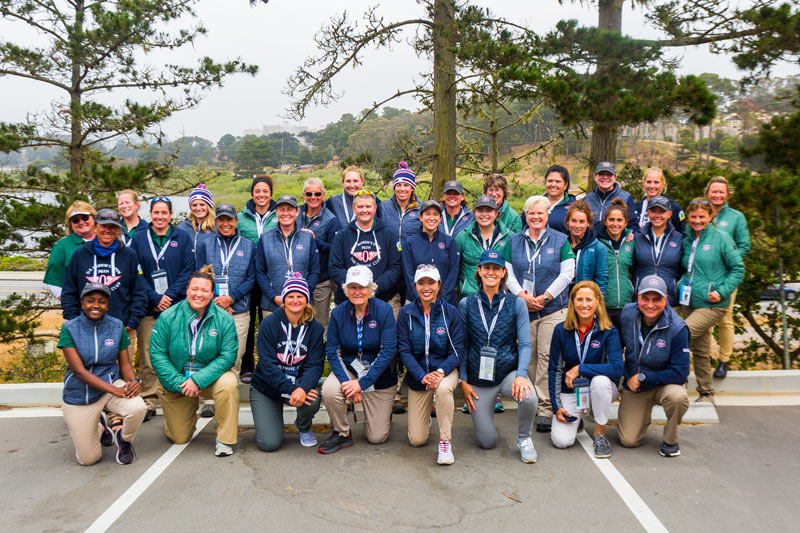
Volunteers at the U.S. Women’s Open gather with members of The Olympic Club and director of golf maintenance Troy Flanagan (front row, right) on Tuesday, June 1. Photo by Ben Wick
It’s dark, drizzly and a tad soupy early on Wednesday, June 2. As the song goes, it’s 5 o’clock somewhere, and while that reference isn’t to 5 in the morning, for Lora Beth West, anytime she can hop behind the wheel of a fairway mower at a historic venue like San Francisco’s The Olympic Club is a happy hour.
You see, these opportunities don’t come along that often, and West and other women in turf are making golf industry history this week at the 76th U.S. Women’s Open. Twenty-nine women make up roughly half of the volunteer grounds crew for Olympic Club director of golf maintenance Troy Flanagan, a 27-year GCSAA member who first hatched the idea to organize a women-in-turf volunteer force a couple of years ago.
Of course, this isn’t the first time women have volunteered at a major championship or other professional tournament, West included. Usually, though, you can count them on one hand. The number of women at work on the golf course and the scale of this week’s event makes this occasion different. Special. West can feel it and see it. “Before, women would get looks. Now, what we do seems to be more accepted,” says West, assistant director of agronomy at Hillcrest Country Club in Los Angeles and a four-year GCSAA member. “I definitely think things are changing.”
Absolutely, according to Tami Jones, GCSAA Class A superintendent at DeSoto Golf Course in Hot Springs Village, Ark., who is certain this championship represents a giant leap for women in the golf course management profession. “This opens up the industry, opens doors,” says Jones, a 14-year association member. “It’s an opportunity for young girls looking for something to do.”
The women pitching in at The Olympic Club this week represent various segments of the turfgrass industry, from golf to sports fields to academia. Beth Guertal, Ph.D., a professor in the Department of Crop, Soil and Environmental Sciences at Auburn University, has been busy, as she says, “fluffing the rough,” all the while gathering information she’ll take back to Alabama to impart when school reconvenes. “To be here and see this firsthand to this degree and to share with my students is the absolute tops,” Guertal says.
Watch: Follow The Olympic Club’s maintenance team during this week’s course prep, and hear from some of the female volunteers on what the experience has meant to them:
For Flanagan, the initial idea for the women’s volunteer program came when Bayer launched its Women in Golf professional development event in 2019. Flanagan’s goal for the U.S. Women’s Open volunteers was to combine the typical tournament-preparation tasks with educational opportunities. When he stopped by the Rain Bird booth at GCSAA’s 2020 Golf Industry Show in Orlando, Fla., he mentioned his idea Stuart Hackwell, director of Rain Bird’s golf strategic business unit. “He said, ‘I want to do something that’s never been done before,’” Hackwell recalls. “My thought was, ‘What can we do to help?’ I explained it to our board of directors, and they said it makes sense.” Rain Bird made a crucial contribution to Flanagan’s vision by paying for the female volunteers’ flights to the City by the Bay.
Flanagan collaborated on the education facet with Syngenta and one of its territory managers, Kimberly Gard, who spearheaded the speaker lineup and the outreach to identify volunteers. This week, educational opportunities have filled the time between the completion of the morning shift and the start of afternoon duties. On Wednesday, Amy Wallis, Ph.D., professor of practice in organizational behavior at Wake Forest University, delivered a presentation entitled “Leading While Female.”
Flanagan even got his family involved in the week’s activities. His wife, Mary, and daughter Erin worked with the female volunteers to ensure there were no uniforms issues. “I wanted this as perfect as I could get it,” Flanagan says.
The Olympic Club’s Ocean Course superintendent, Andrew Crawford, is familiar with Flanagan’s desire for perfection. “With COVID, working through everything with the USGA, he didn’t stop,” says Crawford, a nine-year GCSAA member. “You could see why. They (female volunteers) are making a name for themselves. Their performance shows it. You can tell this isn’t just a vacation in San Francisco. They might as well be part of the crew.”
Thom Irvin, GCSAA Class A superintendent at The Olympic Club’s Lake Course, says the female volunteers have made everyone raise their game. “I’ve volunteered at events. This is different. There’s more excitement and energy this week,” says Irvin, an 18-year GCSAA member. “It’s like a breath of fresh air. The women have been inspiring. And they’re really good at what they do.”
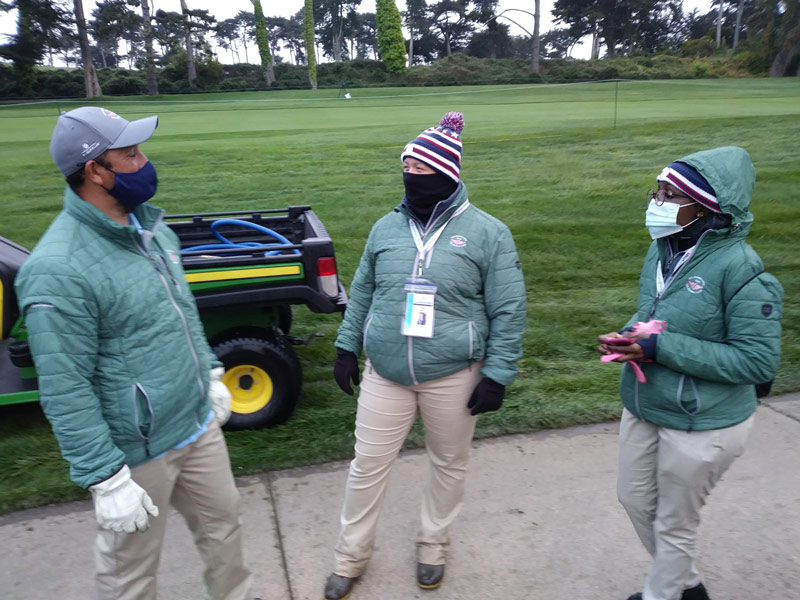
From left: Yuber Castaneda, a 20-year member of the grounds crew at The Olympic Club, chats with volunteers Brandi Merrick, a graduate student at North Carolina State University, and Maureen Kahiu, a graduate student at Penn State.
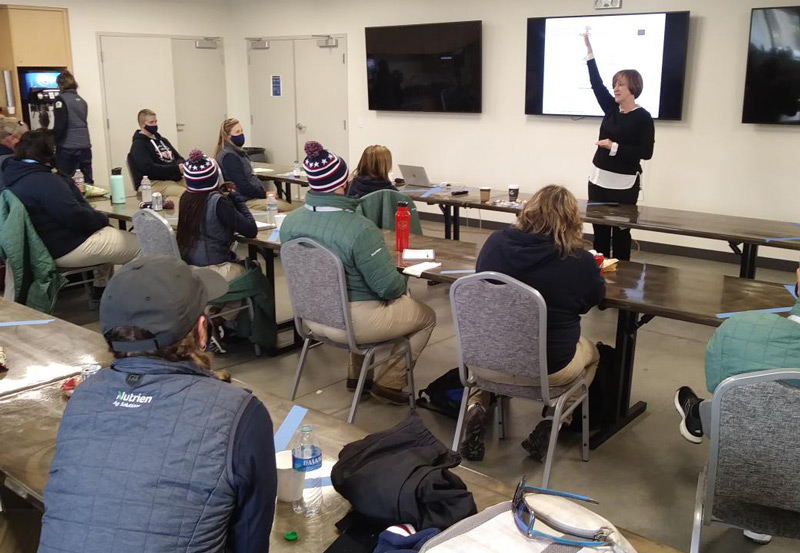
Amy Wallis, Ph.D., presents the education session “Leading While Female” to U.S. Women’s Open volunteers on Wednesday, June 2.
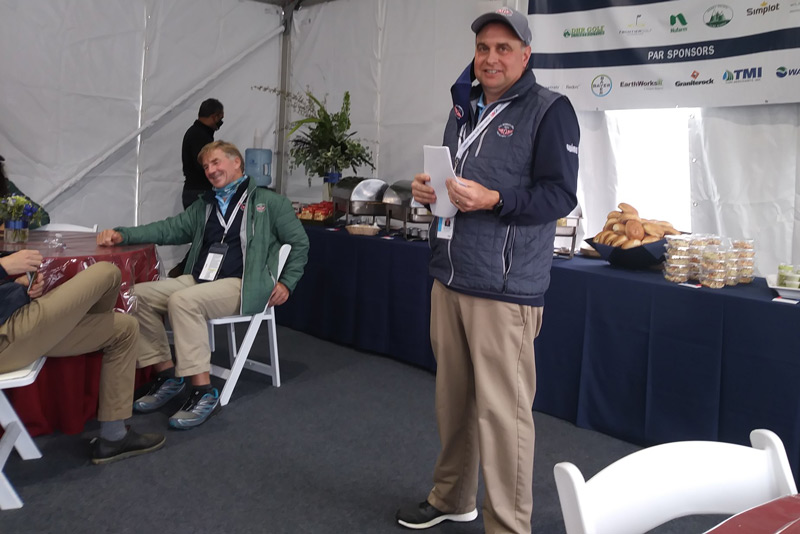
Troy Flanagan, director of golf maintenance at The Olympic Club, addresses crew members and volunteers Wednesday evening.
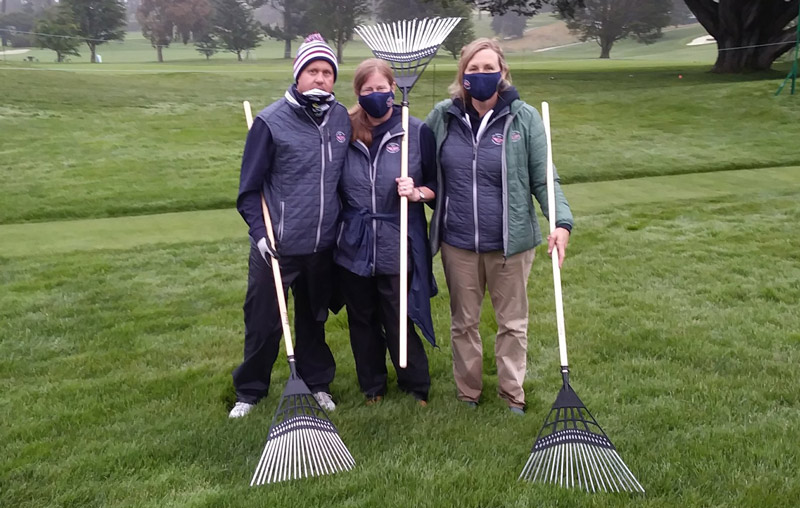
From left: GCSAA Southwest regional field staff representative Jeff Jensen; Auburn University professor Beth Guertal, Ph.D.; and Syngenta territory manager Kimberly Gard tackle their course maintenance tasks before play kicks off Thursday morning. Photos by Howard Richman
Susan Spahr, CGCS, a 26-year GCSAA member who oversees Swanhills Golf Course in Belvidere, Ill., digs the work at The Olympic Club, and something else has made the experience even more satisfying. “You’re always learning on the job, and that usually is the most important thing,” Spahr says, “but things have kind of changed. It’s the camaraderie, the friendships being made. The men here have been just amazing. Outgoing. Kind. It’s not a gender issue. We all work well together. It’s just fun. I’m pretty grateful.”
The USGA admires what Flanagan has facilitated for Spahr and her peers. “When we talk about diversity, it’s about coming together and providing opportunities,” says Darin Bevard, director of championship agronomy for the USGA Green Section.
Flanagan is undoubtedly thankful for what the female volunteers have brought to The Olympic Club’s first U.S. Women’s Open. Speaking about wanting to volunteer at previous tournaments, “One of the girls said it was like having a dance, wanting to go to the dance, and not being asked,” Flanagan says. “All they want is a chance.”
Editor’s note: Learn more about women blazing trails in the turf industry and read more of their stories and insights in GCMOnline.com’s women in turf collection.
Women were not allowed to be members of The Olympic Club until 1990. On Tuesday, some of the club’s female members were on hand to speak to the volunteers.
For Brianne Kenny, hearing from those women was moving. “I can’t remember the last time I cried until here,” says Kenny, environmental science manager for Troon Golf who’s one of the volunteers on the greens mowing crew. “Speaking with those women, I teared up. Out here, it feels like we’re sisters next to each other, doing the work, and it feels amazing. I know it’s just the beginning. There’s so many women deserving to be here. If this trend continues, I think you’re going to see this year after year.”
The 2021 U.S. Women’s Open: Golf course facts
The 2021 U.S. Women’s Open will be held June 3-6 on the Lake Course at The Olympic Club in San Francisco.
The grass
Greens: Creeping bentgrass maintained at .100 inch
Tees: Poa annua/perennial ryegrass maintained at .350 inch
Fairways: Poa annua maintained at .400 inch
Rough: Perennial ryegrass maintained at 4.25 inch
The course
Year built: 1924
Architect: Willie Watson
Renovation: In 2009, Bill Love built the Lake Course greens to USGA specifications and renovated holes No. 7 and 8.
Average green size: 4,150 square feet
Acres of fairway: 24
Acres of rough: 72
Number of sand bunkers: 56
Number of water hazards: 0
Soil conditions: Native sands
Water sources: Effluent
Par: 35-36—71
Yardage: 6,457
Stimpmeter: 12.5
- The Olympic Club was established in 1860, and Mark Twain was among its earliest members (before the golf courses were built). The club has two 18-hole courses, the Lake Course and the Ocean Course, and a nine-hole course, the Cliffs Course. The club has hosted the men’s U.S. Open five times.
- The Lake Course received just one-fourth of the usual rainfall this past winter, which allowed the agronomy team to prime the course, but also required earlier irrigation.
- The right side of No. 2 fairway has been narrowed by 15 feet in the landing area. The right side of No. 14 fairway has been narrowed by 18 feet in the landing area. A low-mow area has been reintroduced to the left of No. 13 green. No. 16 tee has been widened 15 feet to the right.
The staff
Troy Flanagan is the director of golf maintenance at The Olympic Club, where he has worked for seven years. A graduate of Penn State University, Flanagan previously worked as an assistant superintendent at Cypress Point Club in Pebble Beach, Calif.; superintendent at Round Hill Country Club in Alamo, Calif.; and superintendent at Anthem Country Club in Henderson, Nev. The 27-year GCSAA member is from Richfield, Minn.
Other key golf personnel:
Thom Irvin, Lake Course superintendent
Andrew Crawford, Ocean Course and Cliffs Course superintendent
Kyle Moore, assistant superintendent
Jared Kief, assistant superintendent
Kyle Wilker, assistant superintendent
Zachary Erixon, assistant superintendent
Phillip Gill, equipment manager
Will Hutter, director of golf
Chris Stein, PGA professional
Number of employees: 48
Number of tournament volunteers: 62
Howard Richman is GCM’s associate editor.